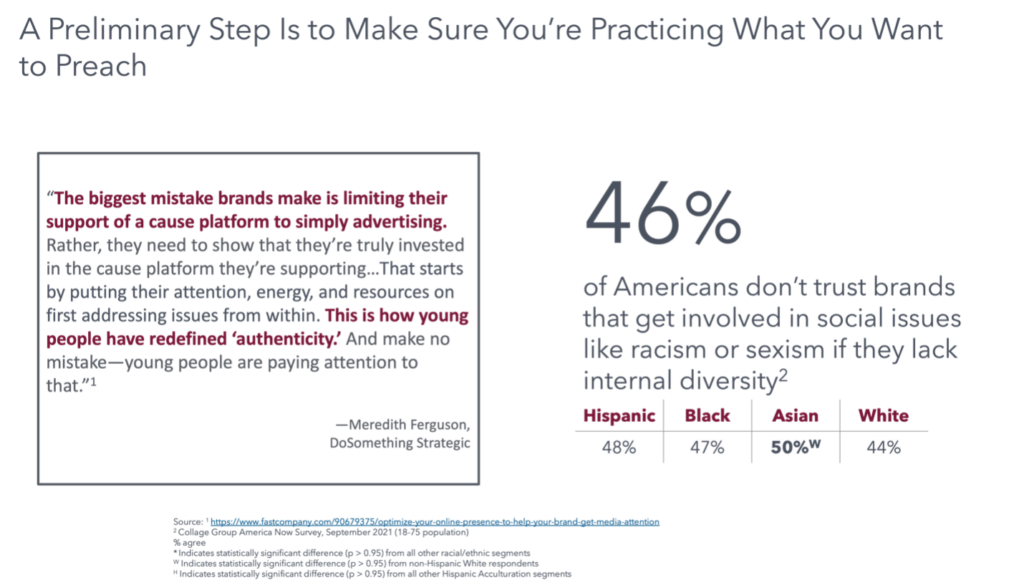Authentically Engage Multicultural America Now

It’s no secret that over the past two years, multicultural consumers have changed how they evaluate and view brands.
But, do brands truly know how multicultural American consumers’—responsible for more than 100 percent of total population growth—have changed since the unprecedented social, economic and public health upheavals since 2020? Or how to effectively engage them through advertising?
To answer this question and more, I was joined by my colleagues David Evans, Collage Group Chief Insights Officer, and Jack Mackinnon, Director of Product & Content, to present at the Quirk’s Event in New York City: a valuable collection of sessions and networking opportunities with leaders in the marketing research and insights field.
In the first part of our session, which included highlights from our “America Now” study, Jack Mackinnon unveiled key changes in Asian, Black and Hispanic consumers’ attitudes and priorities since 2020. Attendees learned what these changes in perspectives mean for their brands, such as how to support the changing landscape of diverse American consumers.
One key takeaway from America Now: when brands that act on social movements, they are more likely to connect with multicultural consumers. However, brands also must accurately portray diverse stories and communities while ensuring that they are being authentic themselves.
Currently, many multicultural Americans are not satisfied with how they are being portrayed by brands. Which means there is an important opportunity for brands to explore how they are portraying multicultural consumers and ensure those representations are authentic. Consumers want brands to portray race and ethnicity accurately, but also want them to include the unique stories that are often not portrayed in advertising. This requires brands dig deeper into multicultural Americans and their stories and develop the diverse advertising campaigns more likely to connect across multicultural consumer groups.
Furthermore, shying away from action on social movements can be harmful for brands, specifically among younger consumer groups, and requires much more than running diverse ad campaigns. In fact, 25% of Black consumers and 21% of Hispanic consumers say they will stop buying from brands that do not take a stance on a social or political issues that are important to them. And for all multicultural consumers, they want to see diversity woven throughout the organization, including internal diversity vs. simply limiting support for a cause to an advertising campaign.

So then how do brands ensure they are connecting with multicultural Americans authentically? The answer is in embedding Cultural Fluency throughout the organization–to engage efficiently and effectively across consumer segments.
In his presentation explaining the “halo effect” of diverse advertising, David Evans explained that Cultural Fluency is an emerging marketing mandate that can no longer be understood as a sideshow to the main act of “mainstream marketing.” It’s a necessary component for connection and growth among multicultural American consumers.
David explained that Culturally Fluent ads that aim to connect with a single story or community can have a halo effect across other consumer segments. For example, many Black and Hispanic centered segmented campaigns halo across other segments, allowing brands to reach even more consumers authentically, especially if the focus is on the “story”. Further White consumers are also responding well to multicultural ads.
We know this because help brands succeed with Cultural Fluent advertising, Collage Group created CultureRate, which leverages 10+ years of research and expertise in the survey design methods needed to understand diverse America. CultureRate is generating 30+ million datapoints annually, with nearly one million consumer responses collected since 2018. It allows our research team–and member brands–to reference the largest database of culturally focused consumer response to ads and brands growing at an annual rate of 100-120 ads, 50,000 of responses or 9 million datapoints.
From an deep analysis of this database, David and his team have unveiled 4 key areas for advertisers to take action on to increase their ROI from the halo effects. Download the excerpt above from the presentation to learn more.
Thank you again to our peers and partners at Quirk’s Media for the opportunity to share this important research. Contact us to learn how membership to our cultural intelligence platform will help your brand harness cultural insights for growth.